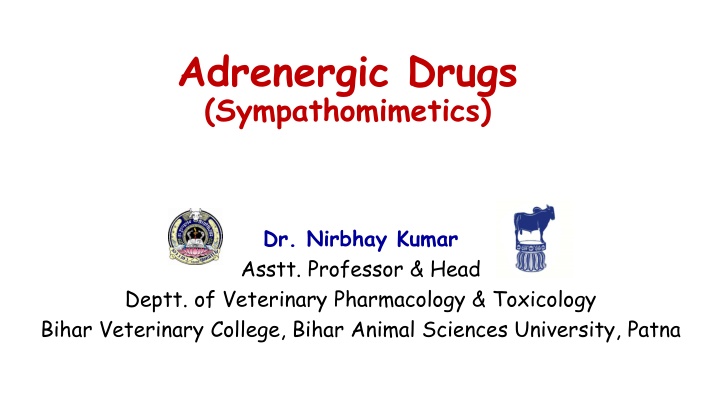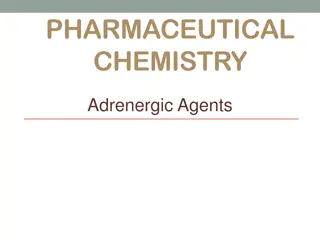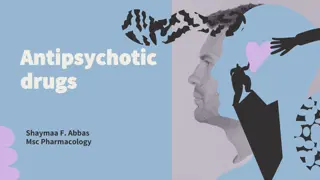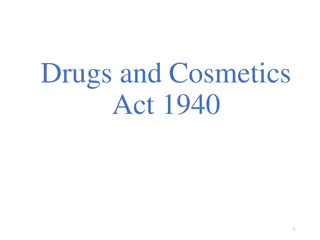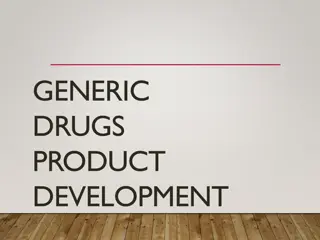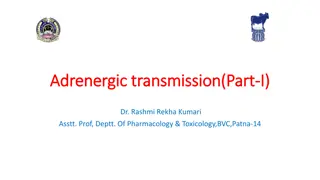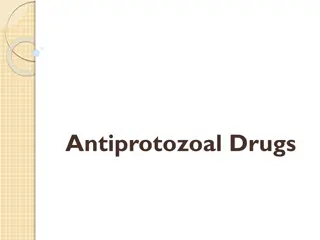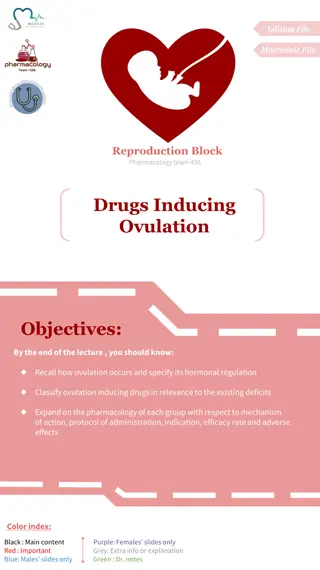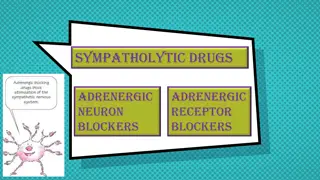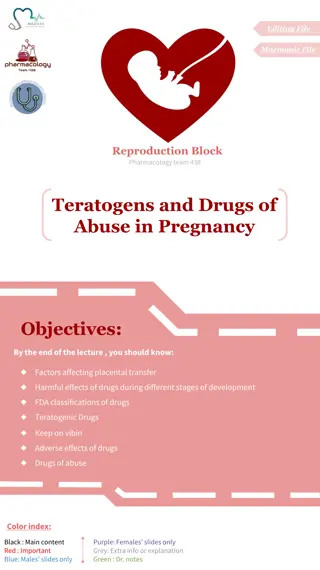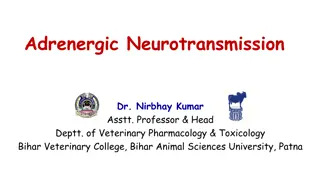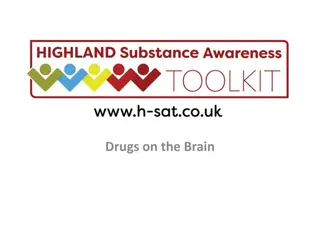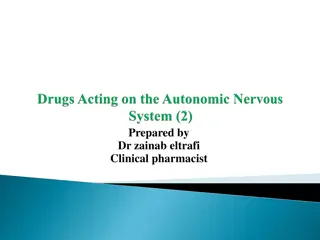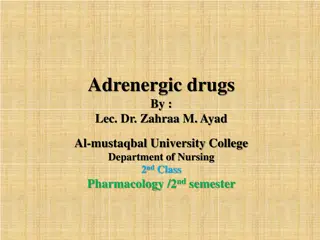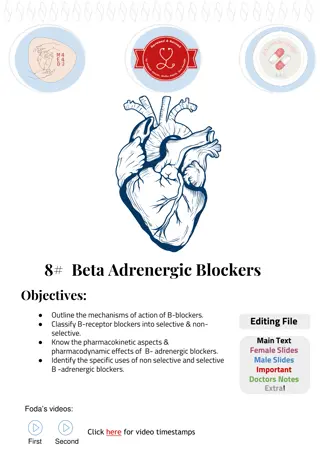Adrenergic Drugs: Effects and Classification
Adrenergic drugs, also known as sympathomimetics, mimic sympathetic stimulation effects. Learn about their classification based on chemical structure and mechanism of action, as well as their pharmacological effects like heart rate increase and blood vessel reactions. Explore Dale's Reversal Phenomenon and understand how adrenergic drugs impact blood pressure.
Download Presentation

Please find below an Image/Link to download the presentation.
The content on the website is provided AS IS for your information and personal use only. It may not be sold, licensed, or shared on other websites without obtaining consent from the author.If you encounter any issues during the download, it is possible that the publisher has removed the file from their server.
You are allowed to download the files provided on this website for personal or commercial use, subject to the condition that they are used lawfully. All files are the property of their respective owners.
The content on the website is provided AS IS for your information and personal use only. It may not be sold, licensed, or shared on other websites without obtaining consent from the author.
E N D
Presentation Transcript
Adrenergic Drugs (Sympathomimetics) Dr. Nirbhay Kumar Asstt. Professor & Head Deptt. of Veterinary Pharmacology & Toxicology Bihar Veterinary College, Bihar Animal Sciences University, Patna
Adrenergic Drugs (Sympathomimetics) These are drugs which mimic the effects of sympathetic stimulation or those of catecholamines. Their effects are due to stimulation of adrenergic receptors (directly or indirectly) on the effector cells, hence also called as adrenergic drugs.
Classification of Adrenergic Drugs (I) Classification based on chemical structure: (1) Catecholamines : Epinephrine, Norepinephrine, Dopamine and Isoproterenol. : Phenylephrine, Ephedrine, Amphetamine, Tyramine etc. (2) Non-catecholamines (II) Classification based on mechanism of action: 1. Directly acting agents: They act directly as agonists on a and/ or b- adrenergic receptors. e.g. Epinephrine, NE, Isoproterenol. 2. Indirectly acting agents: They act on adrenergic neurons to release noradrenaline which then acts on the adrenergic receptors. e.g. Tyramine. 3. Mixed acting agents: They act directly as well as indirectly. e.g. Ephedrine.
Pharmacological Effects of Adrenergic Drugs 1. Heart ( 1, 1): Increase in heart rate (positive chronotropic effect) and Increase in force of cardiac contraction (positive inotropic effect). 2. Blood vessels (Mainly 1 but also 2): Both vasoconstriction ( 1 mediated) and vasodilatation ( 2 mediated). There is dilatation of blood vessels in skeletal muscles, lungs and mesentery ( 2 action).
Pharmacological Effects of Adrenergic Drugs contd Dale s Reversal Phenomenon: Blood vessels More and less 2 receptors. 2 receptors more powerful and sensitive. Epinephrine causes increase which is followed by decrease in blood pressure. The initial rise in B.P. is mediated by receptors which are more in number. As the concentration of epinephrine decreases by metabolism or elimination, it dissociates first from the less sensitive receptors. So, at later stage, the number of activated 2 receptors remains more than the activated receptors which cause decrease in blood pressure. Presence of receptor blockers like ergot etc. inhibits the rising phase of epinephrine induced B.P. But, 2 receptor mediated action (i.e. fall in blood pressure) predominates. As the effect of epinephrine is reversed by the presence of receptor blockers and this phenomenon was first observed by Dale, the phenomenon is called as Dale s Reversal Phenomenon.
Pharmacological Effects of Adrenergic Drugs contd 3. Respiratory tract ( 2): Relaxation of smooth ms. Of bronchi and trachea. Epinephrine and isoproterenol (but not norepinephrine) are potent bronchodilators. 4. Gastrointestinal tract (Both 1 & 2): Decrease in tone and motility. 5. Eye ( 1): Mydriasis due to contraction of radial muscles. Decreased Intraocular Pressure by enhancing both conventional (via a 2-receptor mechanism) and uveoscleral outflow (perhaps via prostaglandin production) from the eye. 6. Sex organ ( 1): Ejaculation of male sex organ. 7. Metabolism: Metabolic effects like hyperglycaemia ( 1 & 2) due to glycogenolysis and hyperlipaemia ( 3) due to lipolysis. 8. Splenic capsule: Contracts ( ) and more RBCs are poured into circulation. 9. CNS: CNS stimulation causing respiratory stimulation, wakefulness, increase in psychomotor activity and anorectic effect.
Sympathomimetic Agents and their Clinical Uses [I]. Adrenaline (Epinephrine) and Noradrenaline (Norepinephrine): These agents reverse hypotension, hence, called pressoramines . Noradrenaline : Best i.v. infusion. It causes generalized vasoconstriction with increased peripheral resistance and increased systolic and diastolic B.P. Adrenaline : Myocardial stimulation & disordered rhythm of the heart. For this reason, adrenaline is not given intravenously. Uses: With local anaesthetics: Potentiate local anaesthetic action by decreasing absorption of local anaesthetics. As local haemostatic: Arrests bleeding due to local vasoconstriction. In allergic/ anaphylactic reactions and acute bronchial asthma : Epinephrine reverses the acute hypotension and dilates the respiratory passages. As cardiac stimulant: Used in the treatment of acute cardiac arrest AV blocks.
Sympathomimetic Agents and their Clinical Uses contd [II]. Ephedrine: It is a naturally acting alkaloid obtained from Ephedra vulgaris. Mixed acting - Mainly acts indirectly but also has some direct action on & receptors also. It is resistant to MAO and COMT. It is 100 times less potent than adrenaline but longer lasting (4 - 6 hour). It was the first agent to be used clinically in management of asthma. The drug was previously used as bronchodilator, vasoconstrictor, a heart stimulant, a mydriatic and a CNS stimulant. Now-a-days, for most of these purposes, there are preferred drugs which are pharmacologically cleaner, more potent alternatives.
Sympathomimetic Agents and their Clinical Uses contd [III]. Amphetamine (CNS stimulant): It is a synthetic, orally active, largely indirect acting & agonist having euphoriant & habit forming properties in man. It has been used by athletes and given to race horses to improve performance illegally (Doping). The central effects of amphetamine include alertness, increased concentration & attention span, euphoria, talkativeness and increased work capacity. Fatigue is allayed. Hence, athletic performance is improved temporarily followed by deterioration.
Sympathomimetic Agents and their Clinical Uses contd [IV]. Phenylephrine (Vasoconstrictor): It is an 1 agonist (less potent but more long lasting than noradrenaline). It is used in hypotension, in local anaesthetic formulations, in decongestants and in ophthalmology (as 10% solution when pupillary dilatation without loss of accommodation is required). [V]. Isoprenaline (Isoproterenol) {Bronchodilator & Cardiostimulant}: It is a synthetic, mixed b agonist. The drug is resistant to MAO but metabolized by COMT. Bronchodilator ( 2) action to asthma in man. Powerful cardiostimulatory action ( 1) to accelerate ventricular rate in heart block.
Sympathomimetic Agents and their Clinical Uses contd [VI]. Salbutamol (Albuterol) {bronchodilator}: It is a selective 2 agonist (i.e. acting on bronchial muscle, vasculature and the uterus). 2 selectivity is only relative. Salbutamol has 2: 1 action ratio of 10. The drug is lacking the undesirable cardio-excitation side effects of isoprenaline in asthmatics. The drug is resistant to MAO and COMT and is having longer duration of action as compared to isoprenaline. It is used as inhaler by asthmatics. Inhaled salbutamol produces bronchodilatation within 5 minutes and the action lasts for 2 4 hours.
Sympathomimetic Agents and their Clinical Uses contd [VII]. Terbutaline {bronchodilator}: It is similar to salbutamol in properties and use. Inhaled salbutamol and terbutaline are currently the most popular drugs. [VIII]. Isoxuprine {Tocolytic or uterine relaxant}: Selective 2 agonist. Depresses smooth muscle contraction in gravid uterus. So, useful in threatened abortion. [IX]. Clenbuterol: Selective 2 agonist. It is having tocolytic and bronchodilator actions.
